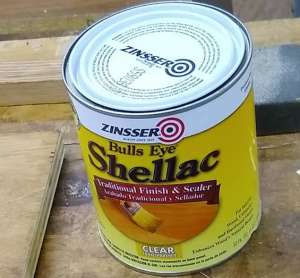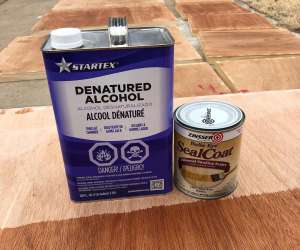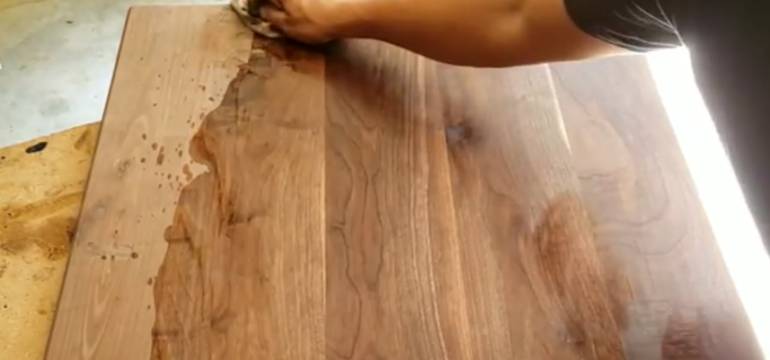Old homes are flush with natural wood trim that cries out for a fresh coat of paint. Maybe you have an old piece of furniture that you want to update with some acrylic paint you have lying around. Many of these old pieces that are left in their natural state are coated with a thick layer of shellac. The question is, can I paint over shellac?
The good news is that you can learn how to paint over shellac in just a few steps. If you want to learn more about how to finish your furniture, take a look at some of these helpful hints!
Will Paint Stick to Shellac?
Whether you are attempting to paint trim or a piece of furniture, many people naturally wonder whether they can paint over shellac. The answer to this question is determined by the type of shellac on the surface of the wood.

Zinnsers bullseye shellac contains about 6 % wax.
There is both waxed shellac and dewaxed shellac. If you were not the person who originally finished this piece, then you may not know whether the shellac is waxed or unwaxed. Unfortunately, there is no simple way to tell the difference between the two.
For those who do know what type of shellac was used, you can move forward with painting the piece appropriately. The shellac does not have to be dewaxed if you plan to use oil-based paint. It does have to be dewaxed if you plan to use waterborne paint.
 Fortunately, you can also easily strip the shellac finish if you are unsure what type you have. It will take less than fifteen minutes and does not require any significant amount of elbow grease.
Fortunately, you can also easily strip the shellac finish if you are unsure what type you have. It will take less than fifteen minutes and does not require any significant amount of elbow grease.
All you have to do is soak a clean rag in denatured alcohol and rub it over the surface of the shellac. This dissolves the finish and gives you a clean slate for putting any type of paint over the surface of the wood. You may want to consider applying a primer before moving ahead with a new coat of paint.
Preparing the Piece for New Paint

Stripping the shellac finish isn’t the only thing you need to do if you plan on painting over shellac. Much like any other painting project, you need to make sure that the surface is clean and properly prepped. You will most likely find that the piece needs to be thoroughly scrubbed and possibly even sanded before you can move forward with painting.
Cleaning can be done using a paper towel soaked in mineral spirits. Continue to replace the paper towel as soon as it gets dirty. You may go through a lot of paper towels, but you don’t want to skip this part of the process. This can quickly get rid of build-up from cleaners, polishes, and other chemicals that can interfere with your paint.
If you find that you need to sand the piece, try using a fine grit sandpaper. Lightly abrade the entire surface until it is even and smooth. When you finish, apply another coat of mineral spirits to help remove some of the dust and ensure that the surface is ready to receive paint.
Latex Paint over Shellac
One of the most popular forms of painting a wooden piece is using standard latex paint. Latex paint can be used to cover up the wood, but the shellac must be in good condition. This means removing any dirt and grime, sanding down parts that have turned gummy, and correcting any places that are “alligator peeling.”
Shellac can actually function as an excellent primer for latex-based paints. It smooths out the surface of the wood and helps to fill in any naturally occurring knots or pinholes. Instead of painting over shellac surface prep and primer, you can simply roll out your final coat of paint.
Can You Shellac Over Acrylic Paint?
Some people are attempting to do the opposite of painting over shellac. They want to learn how to apply shellac over top of their recent paint job to add more shine. The good news is that you can apply several different types of finishes over top of the acrylic paint to make it more durable and add a sheen.
Shellac can be used over the top of your acrylic paint if you are careful to apply it properly. You can use one coat to seal the wood. All you need to do is rub it on liberally and then wipe the surface to seal it. Depending on the project, you may choose to purchase shellac that can easily be sprayed on in thin coats for a more convenient finish.
Proper Preparation
The trick to successfully painting over the shellac is in the preparation of the finish and the wood itself. Be sure to strip the shellac, clean the surface, and sand as necessary. Depending on the state of the shellac, you may even need to consider applying a thin coat of primer before you paint the final coat. Ensuring that everything is in excellent condition upfront is the key to a successful project.
- How to Cut Lexan - September 25, 2020
- Mineral Spirits vs. Mineral Oil - September 25, 2020
- Shellac vs. Polyurethane - September 24, 2020

